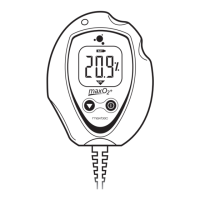5
866.4.Maxtec www.maxtec.com
2.2.2 Direct Flow Calibration (Barb)
1. Attach the Barbed Adapter to the MAXO
2
+ by threading it on to the
bottom of the sensor.
2. Connect the Tygon tube to the barbed adapter. (FIGURE 2, B)
3. Attach the other end of the clear sampling tube to a source of oxygen with
a known oxygen concentration value. Initiate flow of the calibration gas to
the unit. Two liters per minute is recommended.
4. Allow the oxygen to saturate the sensor. Although a stable value is usually
observed within 30 seconds, allow at least two minutes to ensure that the
sensor is completely saturated with the calibration gas.
5. If the MAXO
2
+ is not already turned on, do so now by pressing the
analyzer “ON” button.
6. Press the Cal button on the MAXO
2
+ until you read the word CAL on the
analyzer display. This can take approximately 3 seconds. The analyzer
will now look for a stable sensor signal and a good reading.
When obtained, the analyzer will display the calibration gas on the LCD.
3.0 FACTORS INFLUENCING ACCURATE READINGS
3.1 Elevation/Pressure Changes
»
Changes in elevation result in a reading error of approximately 1% of reading per 250 feet.
»
In general, calibration of the instrument should be performed when elevation at which the
product is being used changes by more than 500 feet.
»
This device does not automatically compensate for changes in barometric pressure
or altitude. If the device is moved to a location of a different altitude, it must be
recalibrated before use.
3.2 Temperature Effects
The MAXO
2
+ will hold calibration and read correctly within ±3% when at
thermal equilibrium within the operating temperature range. The device must
be thermally stable when calibrated and allowed to thermally stabilize after
experiencing temperature changes before readings are accurate. For these
reasons, the following is recommended:
»
For best results, perform the calibration procedure at a temperature close to the
temperature where analysis will occur.
»
Allow adequate time for the sensor to equilibrate to a new ambient temperature.
CAUTION: “CAL Err St” may result from a sensor that has not reached thermal equilibrium.
3.3 Pressure Effects
Readings from the MAXO
2
+ are proportional to the partial pressure of oxygen.
The partial pressure is equal to the concentration times the absolute pressure.
Thus, the readings are proportional to the concentration if the pressure is held
constant. Therefore, the following are recommended:
»
Calibrate the MAXO
2
+ at the same pressure as the sample gas.
»
If sample gases flow through tubing, use the same apparatus and flow rates when
calibrating as when measuring.

